Non-Small Cell Lung Cancer: Pathophysiology, Pharmacodynamics, and Effectiveness of Chemotherapy Drugs
VerifiedAdded on 2022/11/15
|15
|4249
|260
AI Summary
This article discusses the pathophysiology, breathing issues, and metastasis of non-small cell lung cancer. It also explains the pharmacodynamics and pharmacokinetics of chemotherapy drugs like Cisplatin and Docetaxel. The effectiveness of these drugs is compared, and the mechanism of action of each drug is explained.
Contribute Materials
Your contribution can guide someone’s learning journey. Share your
documents today.

Running Head: NSCLC
0
Non- small cell lung cancer
student
[Pick the date]
0
Non- small cell lung cancer
student
[Pick the date]
Secure Best Marks with AI Grader
Need help grading? Try our AI Grader for instant feedback on your assignments.
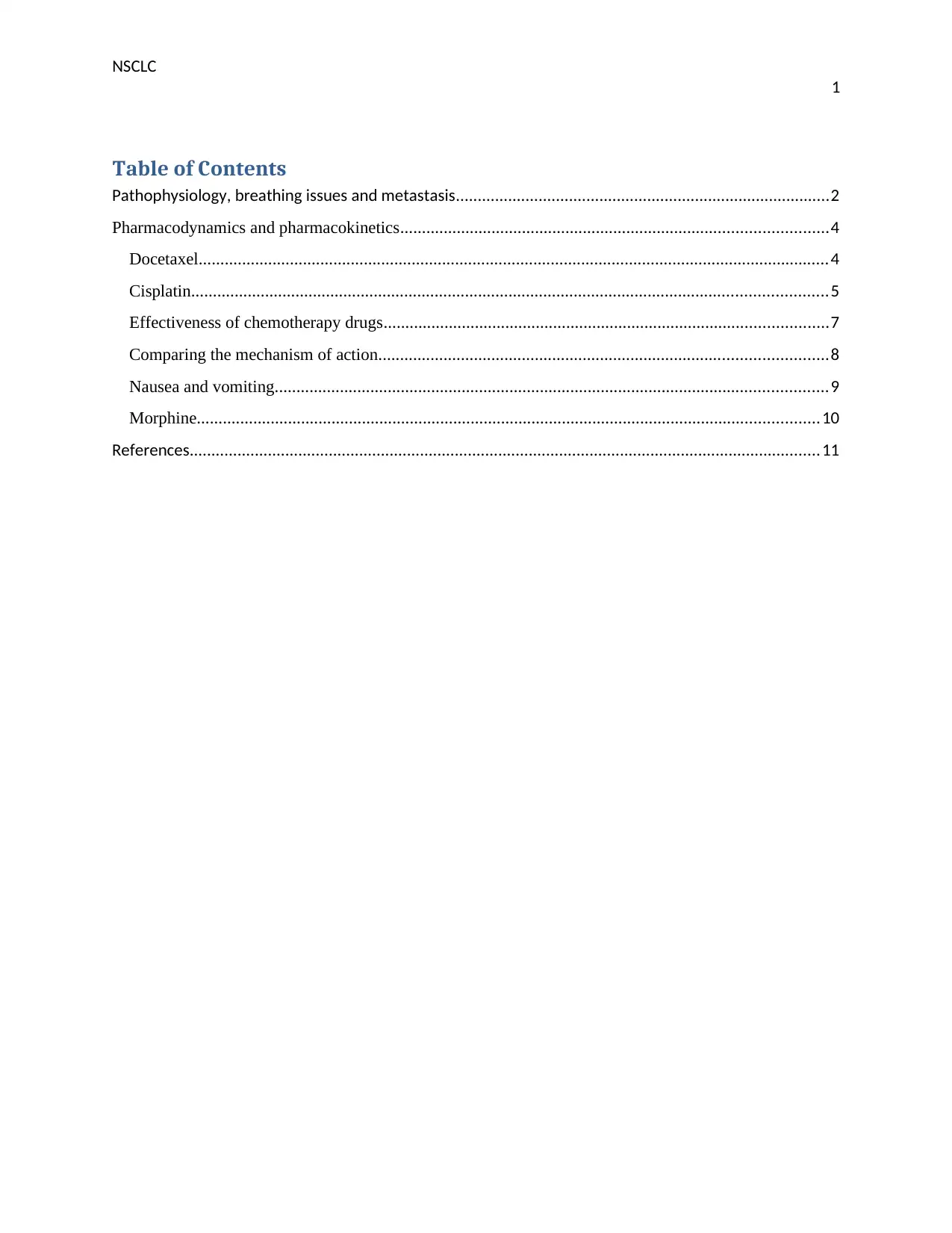
NSCLC
1
Table of Contents
Pathophysiology, breathing issues and metastasis......................................................................................2
Pharmacodynamics and pharmacokinetics..................................................................................................4
Docetaxel.................................................................................................................................................4
Cisplatin..................................................................................................................................................5
Effectiveness of chemotherapy drugs......................................................................................................7
Comparing the mechanism of action.......................................................................................................8
Nausea and vomiting...............................................................................................................................9
Morphine...............................................................................................................................................10
References.................................................................................................................................................11
1
Table of Contents
Pathophysiology, breathing issues and metastasis......................................................................................2
Pharmacodynamics and pharmacokinetics..................................................................................................4
Docetaxel.................................................................................................................................................4
Cisplatin..................................................................................................................................................5
Effectiveness of chemotherapy drugs......................................................................................................7
Comparing the mechanism of action.......................................................................................................8
Nausea and vomiting...............................................................................................................................9
Morphine...............................................................................................................................................10
References.................................................................................................................................................11
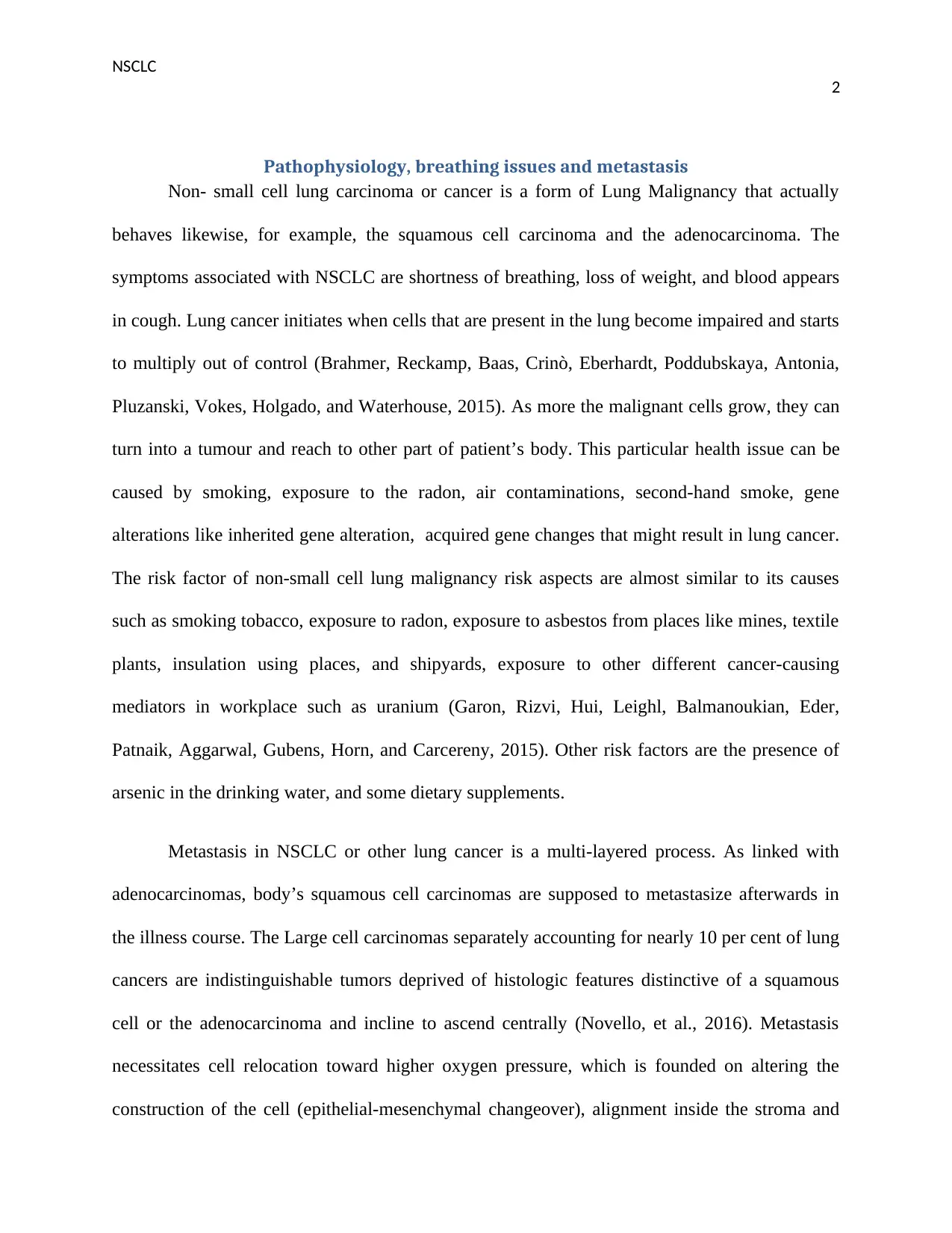
NSCLC
2
Pathophysiology, breathing issues and metastasis
Non- small cell lung carcinoma or cancer is a form of Lung Malignancy that actually
behaves likewise, for example, the squamous cell carcinoma and the adenocarcinoma. The
symptoms associated with NSCLC are shortness of breathing, loss of weight, and blood appears
in cough. Lung cancer initiates when cells that are present in the lung become impaired and starts
to multiply out of control (Brahmer, Reckamp, Baas, Crinò, Eberhardt, Poddubskaya, Antonia,
Pluzanski, Vokes, Holgado, and Waterhouse, 2015). As more the malignant cells grow, they can
turn into a tumour and reach to other part of patient’s body. This particular health issue can be
caused by smoking, exposure to the radon, air contaminations, second-hand smoke, gene
alterations like inherited gene alteration, acquired gene changes that might result in lung cancer.
The risk factor of non-small cell lung malignancy risk aspects are almost similar to its causes
such as smoking tobacco, exposure to radon, exposure to asbestos from places like mines, textile
plants, insulation using places, and shipyards, exposure to other different cancer-causing
mediators in workplace such as uranium (Garon, Rizvi, Hui, Leighl, Balmanoukian, Eder,
Patnaik, Aggarwal, Gubens, Horn, and Carcereny, 2015). Other risk factors are the presence of
arsenic in the drinking water, and some dietary supplements.
Metastasis in NSCLC or other lung cancer is a multi-layered process. As linked with
adenocarcinomas, body’s squamous cell carcinomas are supposed to metastasize afterwards in
the illness course. The Large cell carcinomas separately accounting for nearly 10 per cent of lung
cancers are indistinguishable tumors deprived of histologic features distinctive of a squamous
cell or the adenocarcinoma and incline to ascend centrally (Novello, et al., 2016). Metastasis
necessitates cell relocation toward higher oxygen pressure, which is founded on altering the
construction of the cell (epithelial-mesenchymal changeover), alignment inside the stroma and
2
Pathophysiology, breathing issues and metastasis
Non- small cell lung carcinoma or cancer is a form of Lung Malignancy that actually
behaves likewise, for example, the squamous cell carcinoma and the adenocarcinoma. The
symptoms associated with NSCLC are shortness of breathing, loss of weight, and blood appears
in cough. Lung cancer initiates when cells that are present in the lung become impaired and starts
to multiply out of control (Brahmer, Reckamp, Baas, Crinò, Eberhardt, Poddubskaya, Antonia,
Pluzanski, Vokes, Holgado, and Waterhouse, 2015). As more the malignant cells grow, they can
turn into a tumour and reach to other part of patient’s body. This particular health issue can be
caused by smoking, exposure to the radon, air contaminations, second-hand smoke, gene
alterations like inherited gene alteration, acquired gene changes that might result in lung cancer.
The risk factor of non-small cell lung malignancy risk aspects are almost similar to its causes
such as smoking tobacco, exposure to radon, exposure to asbestos from places like mines, textile
plants, insulation using places, and shipyards, exposure to other different cancer-causing
mediators in workplace such as uranium (Garon, Rizvi, Hui, Leighl, Balmanoukian, Eder,
Patnaik, Aggarwal, Gubens, Horn, and Carcereny, 2015). Other risk factors are the presence of
arsenic in the drinking water, and some dietary supplements.
Metastasis in NSCLC or other lung cancer is a multi-layered process. As linked with
adenocarcinomas, body’s squamous cell carcinomas are supposed to metastasize afterwards in
the illness course. The Large cell carcinomas separately accounting for nearly 10 per cent of lung
cancers are indistinguishable tumors deprived of histologic features distinctive of a squamous
cell or the adenocarcinoma and incline to ascend centrally (Novello, et al., 2016). Metastasis
necessitates cell relocation toward higher oxygen pressure, which is founded on altering the
construction of the cell (epithelial-mesenchymal changeover), alignment inside the stroma and
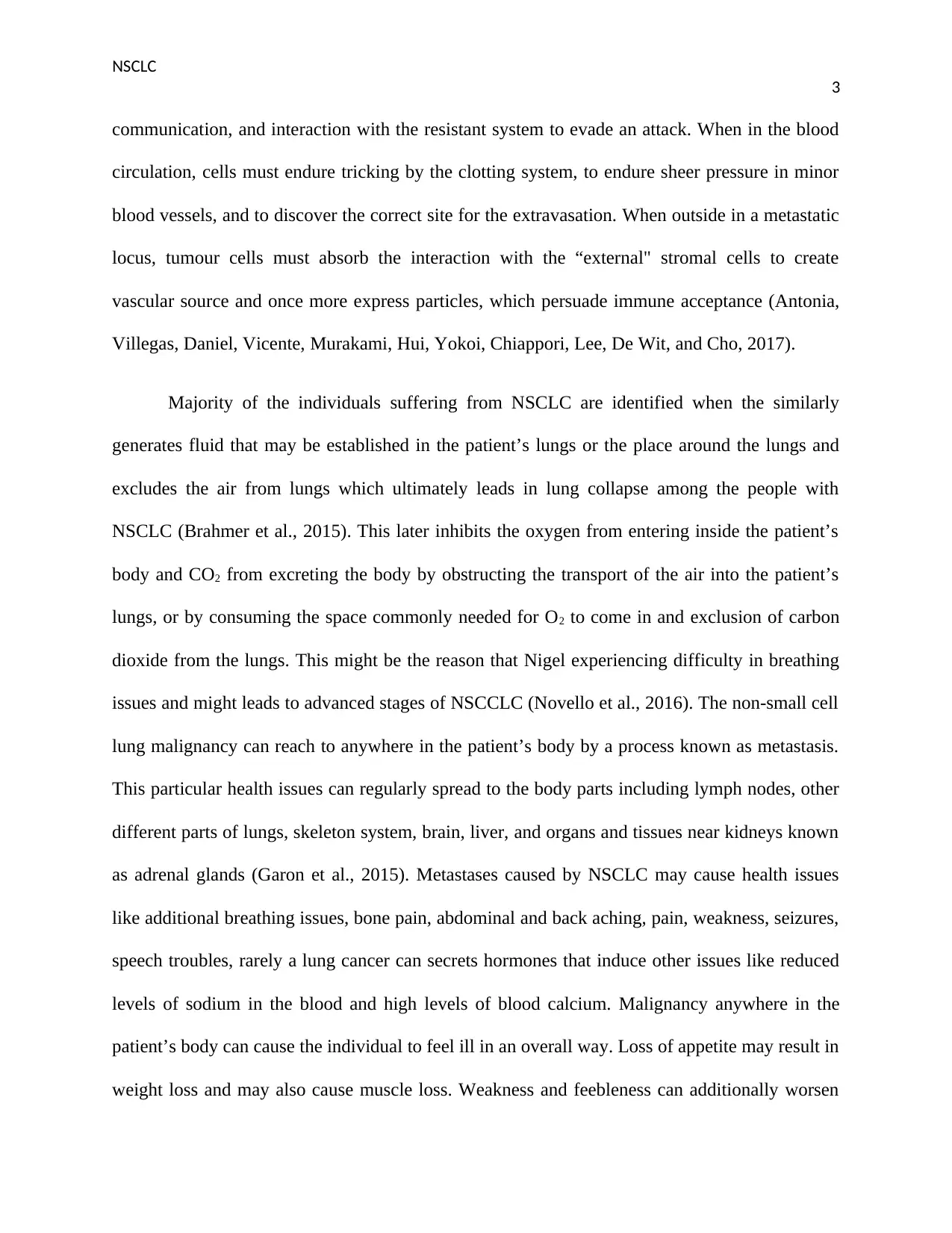
NSCLC
3
communication, and interaction with the resistant system to evade an attack. When in the blood
circulation, cells must endure tricking by the clotting system, to endure sheer pressure in minor
blood vessels, and to discover the correct site for the extravasation. When outside in a metastatic
locus, tumour cells must absorb the interaction with the “external" stromal cells to create
vascular source and once more express particles, which persuade immune acceptance (Antonia,
Villegas, Daniel, Vicente, Murakami, Hui, Yokoi, Chiappori, Lee, De Wit, and Cho, 2017).
Majority of the individuals suffering from NSCLC are identified when the similarly
generates fluid that may be established in the patient’s lungs or the place around the lungs and
excludes the air from lungs which ultimately leads in lung collapse among the people with
NSCLC (Brahmer et al., 2015). This later inhibits the oxygen from entering inside the patient’s
body and CO2 from excreting the body by obstructing the transport of the air into the patient’s
lungs, or by consuming the space commonly needed for O2 to come in and exclusion of carbon
dioxide from the lungs. This might be the reason that Nigel experiencing difficulty in breathing
issues and might leads to advanced stages of NSCCLC (Novello et al., 2016). The non-small cell
lung malignancy can reach to anywhere in the patient’s body by a process known as metastasis.
This particular health issues can regularly spread to the body parts including lymph nodes, other
different parts of lungs, skeleton system, brain, liver, and organs and tissues near kidneys known
as adrenal glands (Garon et al., 2015). Metastases caused by NSCLC may cause health issues
like additional breathing issues, bone pain, abdominal and back aching, pain, weakness, seizures,
speech troubles, rarely a lung cancer can secrets hormones that induce other issues like reduced
levels of sodium in the blood and high levels of blood calcium. Malignancy anywhere in the
patient’s body can cause the individual to feel ill in an overall way. Loss of appetite may result in
weight loss and may also cause muscle loss. Weakness and feebleness can additionally worsen
3
communication, and interaction with the resistant system to evade an attack. When in the blood
circulation, cells must endure tricking by the clotting system, to endure sheer pressure in minor
blood vessels, and to discover the correct site for the extravasation. When outside in a metastatic
locus, tumour cells must absorb the interaction with the “external" stromal cells to create
vascular source and once more express particles, which persuade immune acceptance (Antonia,
Villegas, Daniel, Vicente, Murakami, Hui, Yokoi, Chiappori, Lee, De Wit, and Cho, 2017).
Majority of the individuals suffering from NSCLC are identified when the similarly
generates fluid that may be established in the patient’s lungs or the place around the lungs and
excludes the air from lungs which ultimately leads in lung collapse among the people with
NSCLC (Brahmer et al., 2015). This later inhibits the oxygen from entering inside the patient’s
body and CO2 from excreting the body by obstructing the transport of the air into the patient’s
lungs, or by consuming the space commonly needed for O2 to come in and exclusion of carbon
dioxide from the lungs. This might be the reason that Nigel experiencing difficulty in breathing
issues and might leads to advanced stages of NSCCLC (Novello et al., 2016). The non-small cell
lung malignancy can reach to anywhere in the patient’s body by a process known as metastasis.
This particular health issues can regularly spread to the body parts including lymph nodes, other
different parts of lungs, skeleton system, brain, liver, and organs and tissues near kidneys known
as adrenal glands (Garon et al., 2015). Metastases caused by NSCLC may cause health issues
like additional breathing issues, bone pain, abdominal and back aching, pain, weakness, seizures,
speech troubles, rarely a lung cancer can secrets hormones that induce other issues like reduced
levels of sodium in the blood and high levels of blood calcium. Malignancy anywhere in the
patient’s body can cause the individual to feel ill in an overall way. Loss of appetite may result in
weight loss and may also cause muscle loss. Weakness and feebleness can additionally worsen
Secure Best Marks with AI Grader
Need help grading? Try our AI Grader for instant feedback on your assignments.
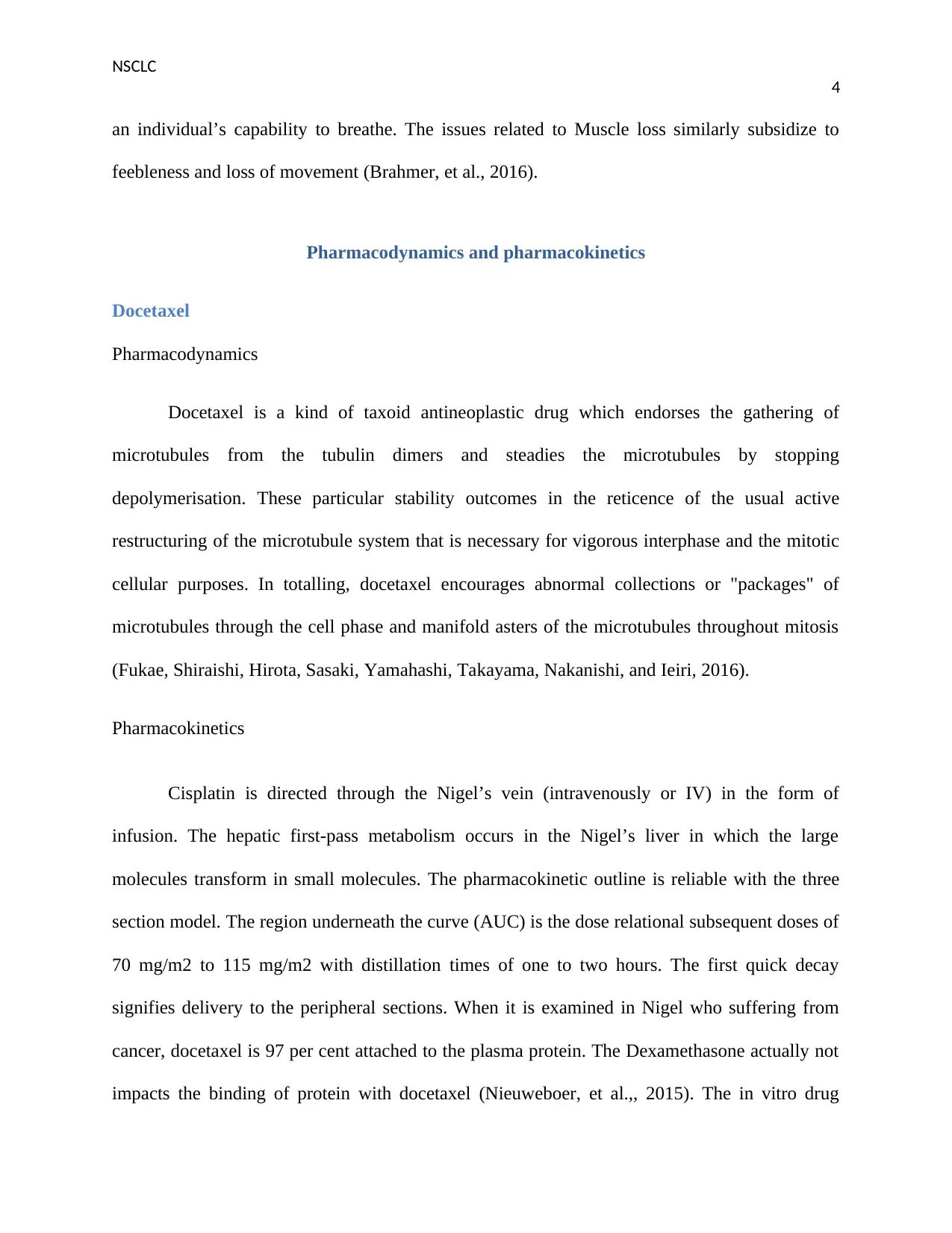
NSCLC
4
an individual’s capability to breathe. The issues related to Muscle loss similarly subsidize to
feebleness and loss of movement (Brahmer, et al., 2016).
Pharmacodynamics and pharmacokinetics
Docetaxel
Pharmacodynamics
Docetaxel is a kind of taxoid antineoplastic drug which endorses the gathering of
microtubules from the tubulin dimers and steadies the microtubules by stopping
depolymerisation. These particular stability outcomes in the reticence of the usual active
restructuring of the microtubule system that is necessary for vigorous interphase and the mitotic
cellular purposes. In totalling, docetaxel encourages abnormal collections or "packages" of
microtubules through the cell phase and manifold asters of the microtubules throughout mitosis
(Fukae, Shiraishi, Hirota, Sasaki, Yamahashi, Takayama, Nakanishi, and Ieiri, 2016).
Pharmacokinetics
Cisplatin is directed through the Nigel’s vein (intravenously or IV) in the form of
infusion. The hepatic first-pass metabolism occurs in the Nigel’s liver in which the large
molecules transform in small molecules. The pharmacokinetic outline is reliable with the three
section model. The region underneath the curve (AUC) is the dose relational subsequent doses of
70 mg/m2 to 115 mg/m2 with distillation times of one to two hours. The first quick decay
signifies delivery to the peripheral sections. When it is examined in Nigel who suffering from
cancer, docetaxel is 97 per cent attached to the plasma protein. The Dexamethasone actually not
impacts the binding of protein with docetaxel (Nieuweboer, et al.,, 2015). The in vitro drug
4
an individual’s capability to breathe. The issues related to Muscle loss similarly subsidize to
feebleness and loss of movement (Brahmer, et al., 2016).
Pharmacodynamics and pharmacokinetics
Docetaxel
Pharmacodynamics
Docetaxel is a kind of taxoid antineoplastic drug which endorses the gathering of
microtubules from the tubulin dimers and steadies the microtubules by stopping
depolymerisation. These particular stability outcomes in the reticence of the usual active
restructuring of the microtubule system that is necessary for vigorous interphase and the mitotic
cellular purposes. In totalling, docetaxel encourages abnormal collections or "packages" of
microtubules through the cell phase and manifold asters of the microtubules throughout mitosis
(Fukae, Shiraishi, Hirota, Sasaki, Yamahashi, Takayama, Nakanishi, and Ieiri, 2016).
Pharmacokinetics
Cisplatin is directed through the Nigel’s vein (intravenously or IV) in the form of
infusion. The hepatic first-pass metabolism occurs in the Nigel’s liver in which the large
molecules transform in small molecules. The pharmacokinetic outline is reliable with the three
section model. The region underneath the curve (AUC) is the dose relational subsequent doses of
70 mg/m2 to 115 mg/m2 with distillation times of one to two hours. The first quick decay
signifies delivery to the peripheral sections. When it is examined in Nigel who suffering from
cancer, docetaxel is 97 per cent attached to the plasma protein. The Dexamethasone actually not
impacts the binding of protein with docetaxel (Nieuweboer, et al.,, 2015). The in vitro drug
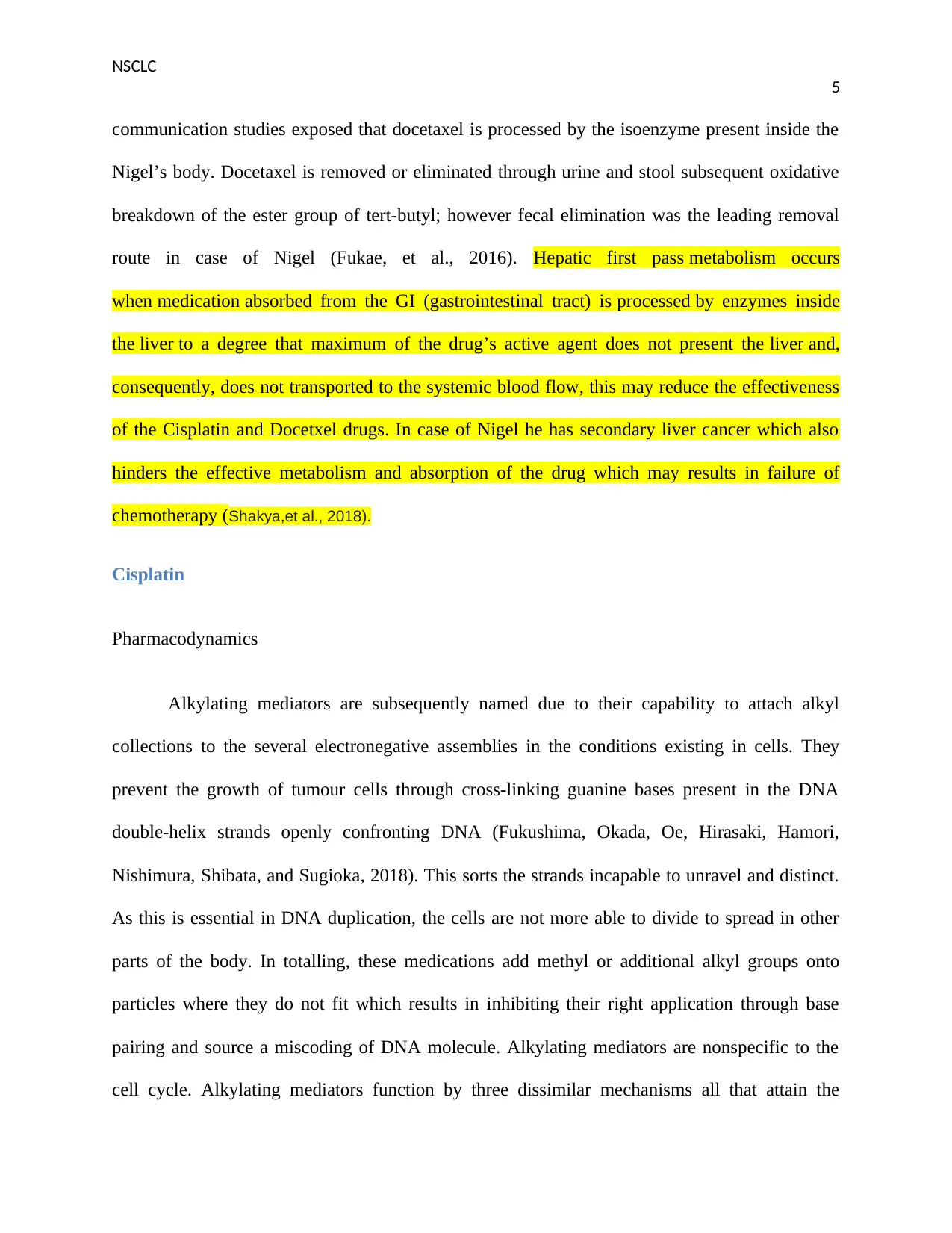
NSCLC
5
communication studies exposed that docetaxel is processed by the isoenzyme present inside the
Nigel’s body. Docetaxel is removed or eliminated through urine and stool subsequent oxidative
breakdown of the ester group of tert-butyl; however fecal elimination was the leading removal
route in case of Nigel (Fukae, et al., 2016). Hepatic first pass metabolism occurs
when medication absorbed from the GI (gastrointestinal tract) is processed by enzymes inside
the liver to a degree that maximum of the drug’s active agent does not present the liver and,
consequently, does not transported to the systemic blood flow, this may reduce the effectiveness
of the Cisplatin and Docetxel drugs. In case of Nigel he has secondary liver cancer which also
hinders the effective metabolism and absorption of the drug which may results in failure of
chemotherapy (Shakya,et al., 2018).
Cisplatin
Pharmacodynamics
Alkylating mediators are subsequently named due to their capability to attach alkyl
collections to the several electronegative assemblies in the conditions existing in cells. They
prevent the growth of tumour cells through cross-linking guanine bases present in the DNA
double-helix strands openly confronting DNA (Fukushima, Okada, Oe, Hirasaki, Hamori,
Nishimura, Shibata, and Sugioka, 2018). This sorts the strands incapable to unravel and distinct.
As this is essential in DNA duplication, the cells are not more able to divide to spread in other
parts of the body. In totalling, these medications add methyl or additional alkyl groups onto
particles where they do not fit which results in inhibiting their right application through base
pairing and source a miscoding of DNA molecule. Alkylating mediators are nonspecific to the
cell cycle. Alkylating mediators function by three dissimilar mechanisms all that attain the
5
communication studies exposed that docetaxel is processed by the isoenzyme present inside the
Nigel’s body. Docetaxel is removed or eliminated through urine and stool subsequent oxidative
breakdown of the ester group of tert-butyl; however fecal elimination was the leading removal
route in case of Nigel (Fukae, et al., 2016). Hepatic first pass metabolism occurs
when medication absorbed from the GI (gastrointestinal tract) is processed by enzymes inside
the liver to a degree that maximum of the drug’s active agent does not present the liver and,
consequently, does not transported to the systemic blood flow, this may reduce the effectiveness
of the Cisplatin and Docetxel drugs. In case of Nigel he has secondary liver cancer which also
hinders the effective metabolism and absorption of the drug which may results in failure of
chemotherapy (Shakya,et al., 2018).
Cisplatin
Pharmacodynamics
Alkylating mediators are subsequently named due to their capability to attach alkyl
collections to the several electronegative assemblies in the conditions existing in cells. They
prevent the growth of tumour cells through cross-linking guanine bases present in the DNA
double-helix strands openly confronting DNA (Fukushima, Okada, Oe, Hirasaki, Hamori,
Nishimura, Shibata, and Sugioka, 2018). This sorts the strands incapable to unravel and distinct.
As this is essential in DNA duplication, the cells are not more able to divide to spread in other
parts of the body. In totalling, these medications add methyl or additional alkyl groups onto
particles where they do not fit which results in inhibiting their right application through base
pairing and source a miscoding of DNA molecule. Alkylating mediators are nonspecific to the
cell cycle. Alkylating mediators function by three dissimilar mechanisms all that attain the
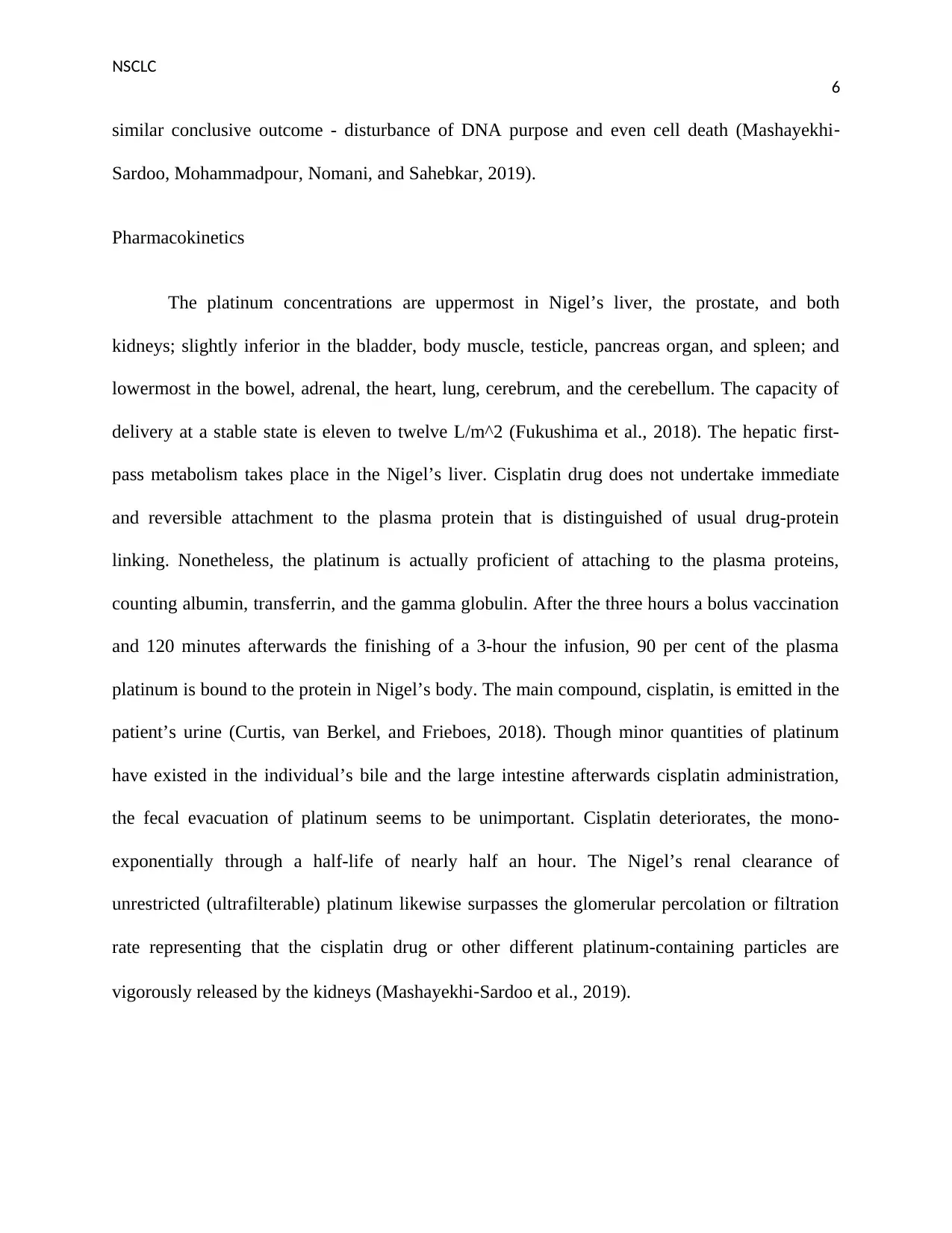
NSCLC
6
similar conclusive outcome - disturbance of DNA purpose and even cell death (Mashayekhi‐
Sardoo, Mohammadpour, Nomani, and Sahebkar, 2019).
Pharmacokinetics
The platinum concentrations are uppermost in Nigel’s liver, the prostate, and both
kidneys; slightly inferior in the bladder, body muscle, testicle, pancreas organ, and spleen; and
lowermost in the bowel, adrenal, the heart, lung, cerebrum, and the cerebellum. The capacity of
delivery at a stable state is eleven to twelve L/m^2 (Fukushima et al., 2018). The hepatic first-
pass metabolism takes place in the Nigel’s liver. Cisplatin drug does not undertake immediate
and reversible attachment to the plasma protein that is distinguished of usual drug-protein
linking. Nonetheless, the platinum is actually proficient of attaching to the plasma proteins,
counting albumin, transferrin, and the gamma globulin. After the three hours a bolus vaccination
and 120 minutes afterwards the finishing of a 3-hour the infusion, 90 per cent of the plasma
platinum is bound to the protein in Nigel’s body. The main compound, cisplatin, is emitted in the
patient’s urine (Curtis, van Berkel, and Frieboes, 2018). Though minor quantities of platinum
have existed in the individual’s bile and the large intestine afterwards cisplatin administration,
the fecal evacuation of platinum seems to be unimportant. Cisplatin deteriorates, the mono-
exponentially through a half-life of nearly half an hour. The Nigel’s renal clearance of
unrestricted (ultrafilterable) platinum likewise surpasses the glomerular percolation or filtration
rate representing that the cisplatin drug or other different platinum-containing particles are
vigorously released by the kidneys (Mashayekhi‐Sardoo et al., 2019).
6
similar conclusive outcome - disturbance of DNA purpose and even cell death (Mashayekhi‐
Sardoo, Mohammadpour, Nomani, and Sahebkar, 2019).
Pharmacokinetics
The platinum concentrations are uppermost in Nigel’s liver, the prostate, and both
kidneys; slightly inferior in the bladder, body muscle, testicle, pancreas organ, and spleen; and
lowermost in the bowel, adrenal, the heart, lung, cerebrum, and the cerebellum. The capacity of
delivery at a stable state is eleven to twelve L/m^2 (Fukushima et al., 2018). The hepatic first-
pass metabolism takes place in the Nigel’s liver. Cisplatin drug does not undertake immediate
and reversible attachment to the plasma protein that is distinguished of usual drug-protein
linking. Nonetheless, the platinum is actually proficient of attaching to the plasma proteins,
counting albumin, transferrin, and the gamma globulin. After the three hours a bolus vaccination
and 120 minutes afterwards the finishing of a 3-hour the infusion, 90 per cent of the plasma
platinum is bound to the protein in Nigel’s body. The main compound, cisplatin, is emitted in the
patient’s urine (Curtis, van Berkel, and Frieboes, 2018). Though minor quantities of platinum
have existed in the individual’s bile and the large intestine afterwards cisplatin administration,
the fecal evacuation of platinum seems to be unimportant. Cisplatin deteriorates, the mono-
exponentially through a half-life of nearly half an hour. The Nigel’s renal clearance of
unrestricted (ultrafilterable) platinum likewise surpasses the glomerular percolation or filtration
rate representing that the cisplatin drug or other different platinum-containing particles are
vigorously released by the kidneys (Mashayekhi‐Sardoo et al., 2019).
Paraphrase This Document
Need a fresh take? Get an instant paraphrase of this document with our AI Paraphraser
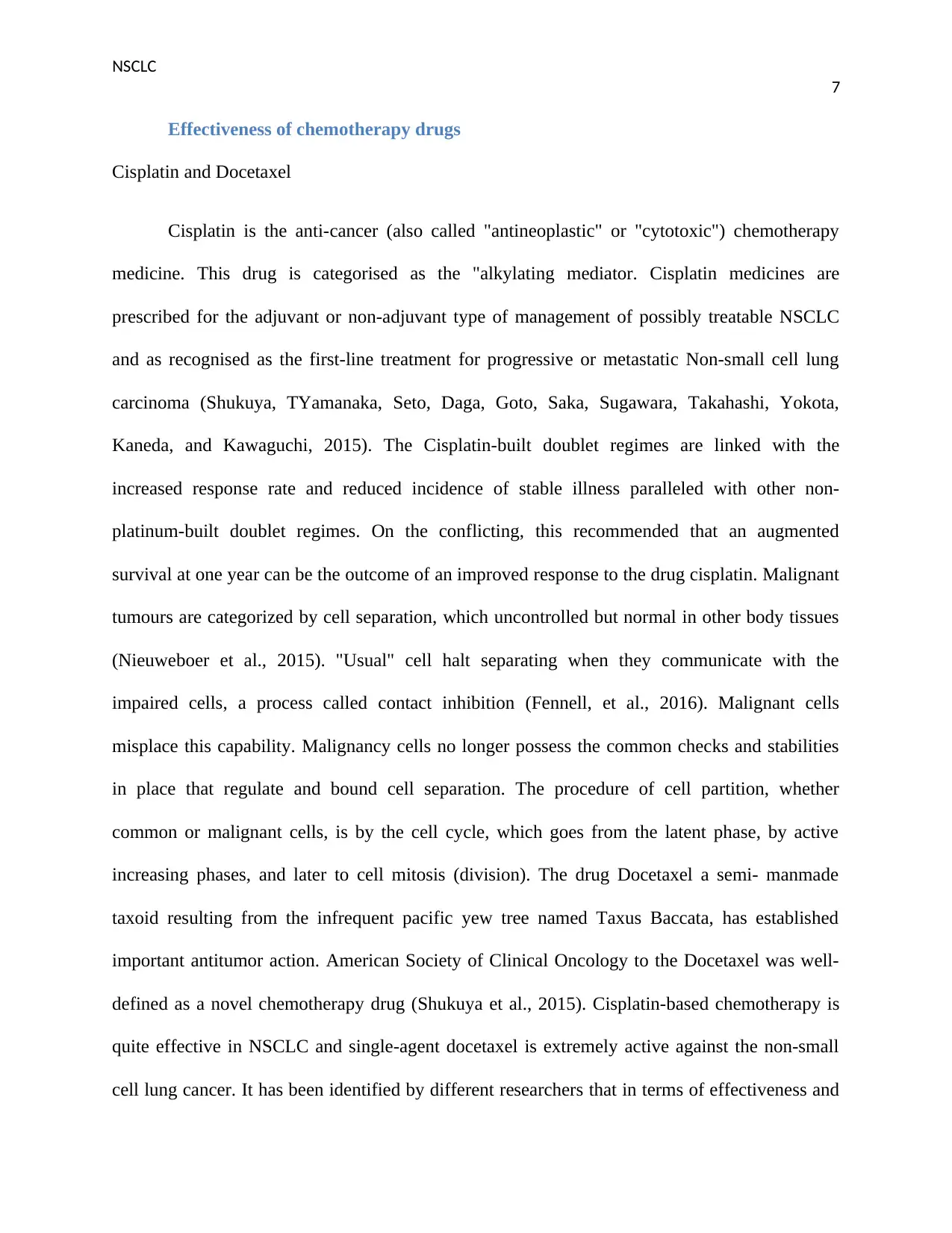
NSCLC
7
Effectiveness of chemotherapy drugs
Cisplatin and Docetaxel
Cisplatin is the anti-cancer (also called "antineoplastic" or "cytotoxic") chemotherapy
medicine. This drug is categorised as the "alkylating mediator. Cisplatin medicines are
prescribed for the adjuvant or non-adjuvant type of management of possibly treatable NSCLC
and as recognised as the first-line treatment for progressive or metastatic Non-small cell lung
carcinoma (Shukuya, TYamanaka, Seto, Daga, Goto, Saka, Sugawara, Takahashi, Yokota,
Kaneda, and Kawaguchi, 2015). The Cisplatin-built doublet regimes are linked with the
increased response rate and reduced incidence of stable illness paralleled with other non-
platinum-built doublet regimes. On the conflicting, this recommended that an augmented
survival at one year can be the outcome of an improved response to the drug cisplatin. Malignant
tumours are categorized by cell separation, which uncontrolled but normal in other body tissues
(Nieuweboer et al., 2015). "Usual" cell halt separating when they communicate with the
impaired cells, a process called contact inhibition (Fennell, et al., 2016). Malignant cells
misplace this capability. Malignancy cells no longer possess the common checks and stabilities
in place that regulate and bound cell separation. The procedure of cell partition, whether
common or malignant cells, is by the cell cycle, which goes from the latent phase, by active
increasing phases, and later to cell mitosis (division). The drug Docetaxel a semi- manmade
taxoid resulting from the infrequent pacific yew tree named Taxus Baccata, has established
important antitumor action. American Society of Clinical Oncology to the Docetaxel was well-
defined as a novel chemotherapy drug (Shukuya et al., 2015). Cisplatin-based chemotherapy is
quite effective in NSCLC and single-agent docetaxel is extremely active against the non-small
cell lung cancer. It has been identified by different researchers that in terms of effectiveness and
7
Effectiveness of chemotherapy drugs
Cisplatin and Docetaxel
Cisplatin is the anti-cancer (also called "antineoplastic" or "cytotoxic") chemotherapy
medicine. This drug is categorised as the "alkylating mediator. Cisplatin medicines are
prescribed for the adjuvant or non-adjuvant type of management of possibly treatable NSCLC
and as recognised as the first-line treatment for progressive or metastatic Non-small cell lung
carcinoma (Shukuya, TYamanaka, Seto, Daga, Goto, Saka, Sugawara, Takahashi, Yokota,
Kaneda, and Kawaguchi, 2015). The Cisplatin-built doublet regimes are linked with the
increased response rate and reduced incidence of stable illness paralleled with other non-
platinum-built doublet regimes. On the conflicting, this recommended that an augmented
survival at one year can be the outcome of an improved response to the drug cisplatin. Malignant
tumours are categorized by cell separation, which uncontrolled but normal in other body tissues
(Nieuweboer et al., 2015). "Usual" cell halt separating when they communicate with the
impaired cells, a process called contact inhibition (Fennell, et al., 2016). Malignant cells
misplace this capability. Malignancy cells no longer possess the common checks and stabilities
in place that regulate and bound cell separation. The procedure of cell partition, whether
common or malignant cells, is by the cell cycle, which goes from the latent phase, by active
increasing phases, and later to cell mitosis (division). The drug Docetaxel a semi- manmade
taxoid resulting from the infrequent pacific yew tree named Taxus Baccata, has established
important antitumor action. American Society of Clinical Oncology to the Docetaxel was well-
defined as a novel chemotherapy drug (Shukuya et al., 2015). Cisplatin-based chemotherapy is
quite effective in NSCLC and single-agent docetaxel is extremely active against the non-small
cell lung cancer. It has been identified by different researchers that in terms of effectiveness and
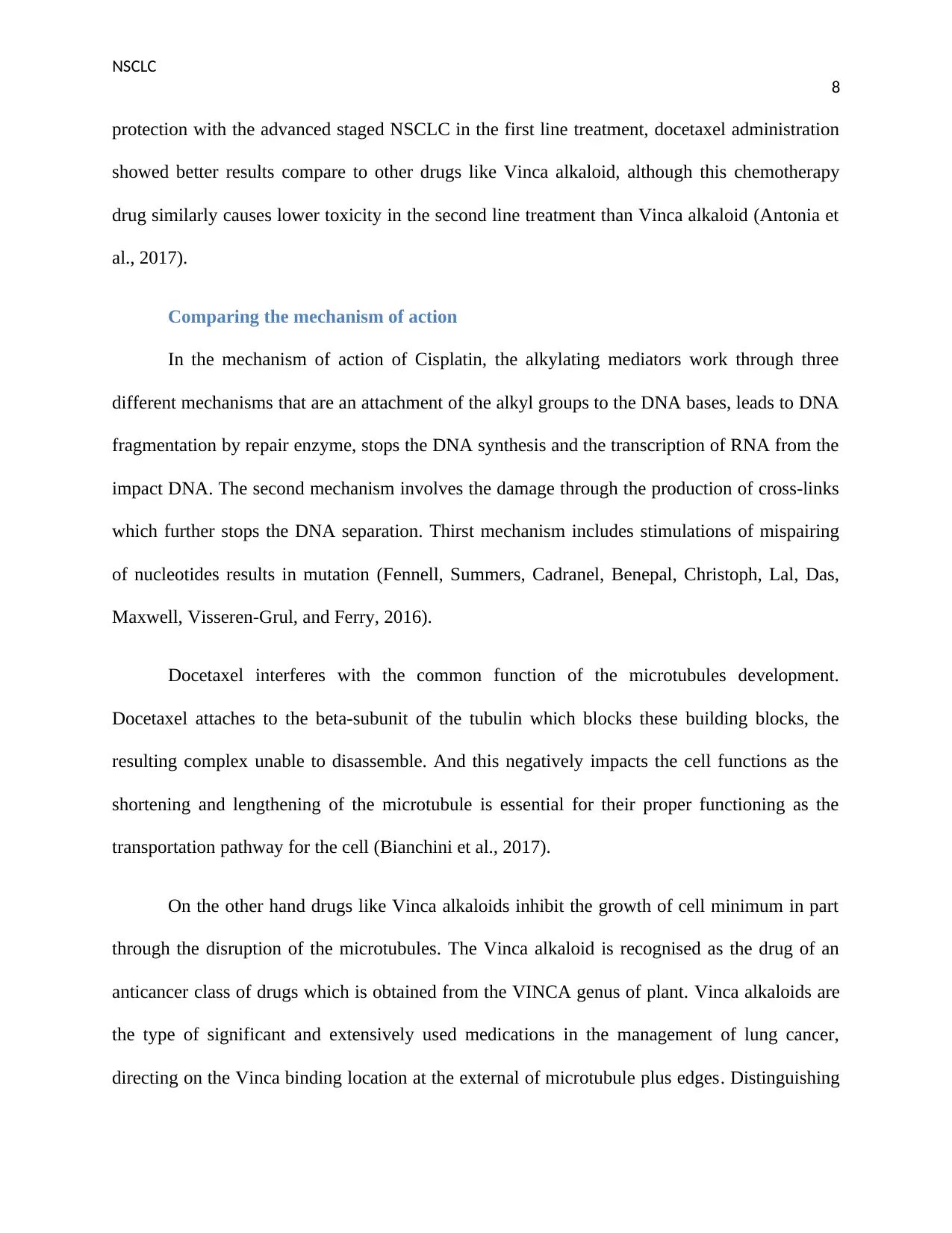
NSCLC
8
protection with the advanced staged NSCLC in the first line treatment, docetaxel administration
showed better results compare to other drugs like Vinca alkaloid, although this chemotherapy
drug similarly causes lower toxicity in the second line treatment than Vinca alkaloid (Antonia et
al., 2017).
Comparing the mechanism of action
In the mechanism of action of Cisplatin, the alkylating mediators work through three
different mechanisms that are an attachment of the alkyl groups to the DNA bases, leads to DNA
fragmentation by repair enzyme, stops the DNA synthesis and the transcription of RNA from the
impact DNA. The second mechanism involves the damage through the production of cross-links
which further stops the DNA separation. Thirst mechanism includes stimulations of mispairing
of nucleotides results in mutation (Fennell, Summers, Cadranel, Benepal, Christoph, Lal, Das,
Maxwell, Visseren-Grul, and Ferry, 2016).
Docetaxel interferes with the common function of the microtubules development.
Docetaxel attaches to the beta-subunit of the tubulin which blocks these building blocks, the
resulting complex unable to disassemble. And this negatively impacts the cell functions as the
shortening and lengthening of the microtubule is essential for their proper functioning as the
transportation pathway for the cell (Bianchini et al., 2017).
On the other hand drugs like Vinca alkaloids inhibit the growth of cell minimum in part
through the disruption of the microtubules. The Vinca alkaloid is recognised as the drug of an
anticancer class of drugs which is obtained from the VINCA genus of plant. Vinca alkaloids are
the type of significant and extensively used medications in the management of lung cancer,
directing on the Vinca binding location at the external of microtubule plus edges. Distinguishing
8
protection with the advanced staged NSCLC in the first line treatment, docetaxel administration
showed better results compare to other drugs like Vinca alkaloid, although this chemotherapy
drug similarly causes lower toxicity in the second line treatment than Vinca alkaloid (Antonia et
al., 2017).
Comparing the mechanism of action
In the mechanism of action of Cisplatin, the alkylating mediators work through three
different mechanisms that are an attachment of the alkyl groups to the DNA bases, leads to DNA
fragmentation by repair enzyme, stops the DNA synthesis and the transcription of RNA from the
impact DNA. The second mechanism involves the damage through the production of cross-links
which further stops the DNA separation. Thirst mechanism includes stimulations of mispairing
of nucleotides results in mutation (Fennell, Summers, Cadranel, Benepal, Christoph, Lal, Das,
Maxwell, Visseren-Grul, and Ferry, 2016).
Docetaxel interferes with the common function of the microtubules development.
Docetaxel attaches to the beta-subunit of the tubulin which blocks these building blocks, the
resulting complex unable to disassemble. And this negatively impacts the cell functions as the
shortening and lengthening of the microtubule is essential for their proper functioning as the
transportation pathway for the cell (Bianchini et al., 2017).
On the other hand drugs like Vinca alkaloids inhibit the growth of cell minimum in part
through the disruption of the microtubules. The Vinca alkaloid is recognised as the drug of an
anticancer class of drugs which is obtained from the VINCA genus of plant. Vinca alkaloids are
the type of significant and extensively used medications in the management of lung cancer,
directing on the Vinca binding location at the external of microtubule plus edges. Distinguishing
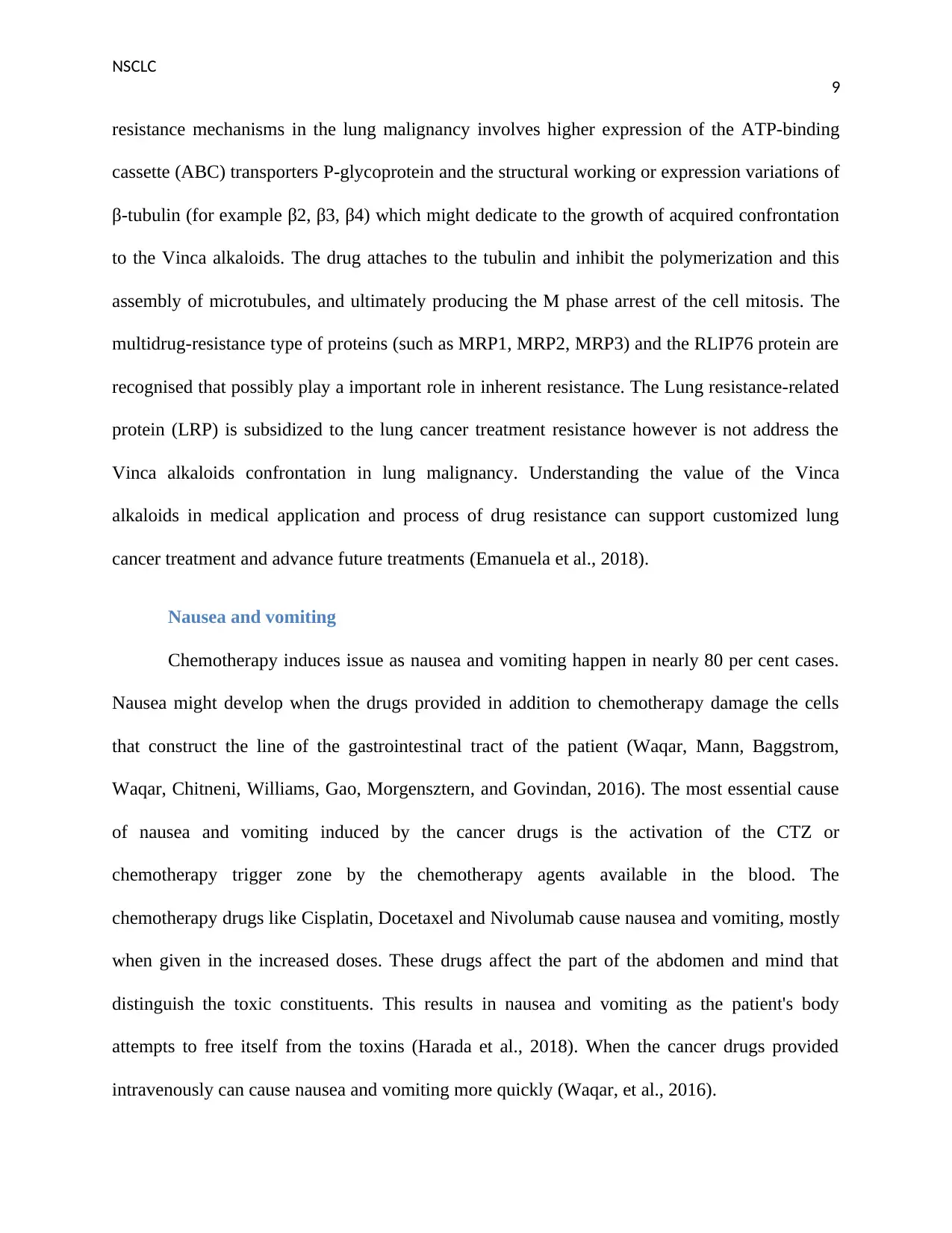
NSCLC
9
resistance mechanisms in the lung malignancy involves higher expression of the ATP-binding
cassette (ABC) transporters P-glycoprotein and the structural working or expression variations of
β-tubulin (for example β2, β3, β4) which might dedicate to the growth of acquired confrontation
to the Vinca alkaloids. The drug attaches to the tubulin and inhibit the polymerization and this
assembly of microtubules, and ultimately producing the M phase arrest of the cell mitosis. The
multidrug-resistance type of proteins (such as MRP1, MRP2, MRP3) and the RLIP76 protein are
recognised that possibly play a important role in inherent resistance. The Lung resistance-related
protein (LRP) is subsidized to the lung cancer treatment resistance however is not address the
Vinca alkaloids confrontation in lung malignancy. Understanding the value of the Vinca
alkaloids in medical application and process of drug resistance can support customized lung
cancer treatment and advance future treatments (Emanuela et al., 2018).
Nausea and vomiting
Chemotherapy induces issue as nausea and vomiting happen in nearly 80 per cent cases.
Nausea might develop when the drugs provided in addition to chemotherapy damage the cells
that construct the line of the gastrointestinal tract of the patient (Waqar, Mann, Baggstrom,
Waqar, Chitneni, Williams, Gao, Morgensztern, and Govindan, 2016). The most essential cause
of nausea and vomiting induced by the cancer drugs is the activation of the CTZ or
chemotherapy trigger zone by the chemotherapy agents available in the blood. The
chemotherapy drugs like Cisplatin, Docetaxel and Nivolumab cause nausea and vomiting, mostly
when given in the increased doses. These drugs affect the part of the abdomen and mind that
distinguish the toxic constituents. This results in nausea and vomiting as the patient's body
attempts to free itself from the toxins (Harada et al., 2018). When the cancer drugs provided
intravenously can cause nausea and vomiting more quickly (Waqar, et al., 2016).
9
resistance mechanisms in the lung malignancy involves higher expression of the ATP-binding
cassette (ABC) transporters P-glycoprotein and the structural working or expression variations of
β-tubulin (for example β2, β3, β4) which might dedicate to the growth of acquired confrontation
to the Vinca alkaloids. The drug attaches to the tubulin and inhibit the polymerization and this
assembly of microtubules, and ultimately producing the M phase arrest of the cell mitosis. The
multidrug-resistance type of proteins (such as MRP1, MRP2, MRP3) and the RLIP76 protein are
recognised that possibly play a important role in inherent resistance. The Lung resistance-related
protein (LRP) is subsidized to the lung cancer treatment resistance however is not address the
Vinca alkaloids confrontation in lung malignancy. Understanding the value of the Vinca
alkaloids in medical application and process of drug resistance can support customized lung
cancer treatment and advance future treatments (Emanuela et al., 2018).
Nausea and vomiting
Chemotherapy induces issue as nausea and vomiting happen in nearly 80 per cent cases.
Nausea might develop when the drugs provided in addition to chemotherapy damage the cells
that construct the line of the gastrointestinal tract of the patient (Waqar, Mann, Baggstrom,
Waqar, Chitneni, Williams, Gao, Morgensztern, and Govindan, 2016). The most essential cause
of nausea and vomiting induced by the cancer drugs is the activation of the CTZ or
chemotherapy trigger zone by the chemotherapy agents available in the blood. The
chemotherapy drugs like Cisplatin, Docetaxel and Nivolumab cause nausea and vomiting, mostly
when given in the increased doses. These drugs affect the part of the abdomen and mind that
distinguish the toxic constituents. This results in nausea and vomiting as the patient's body
attempts to free itself from the toxins (Harada et al., 2018). When the cancer drugs provided
intravenously can cause nausea and vomiting more quickly (Waqar, et al., 2016).
Secure Best Marks with AI Grader
Need help grading? Try our AI Grader for instant feedback on your assignments.
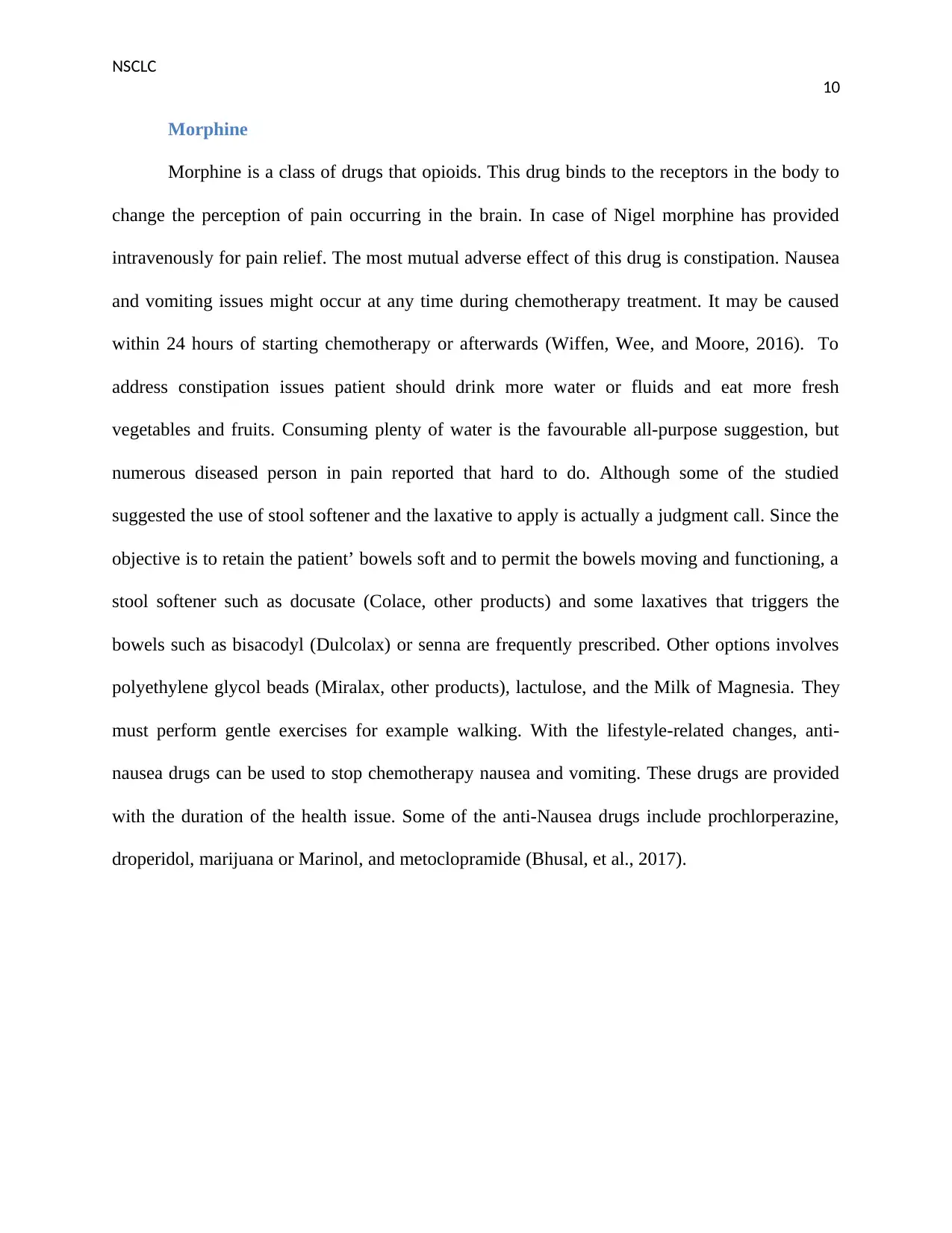
NSCLC
10
Morphine
Morphine is a class of drugs that opioids. This drug binds to the receptors in the body to
change the perception of pain occurring in the brain. In case of Nigel morphine has provided
intravenously for pain relief. The most mutual adverse effect of this drug is constipation. Nausea
and vomiting issues might occur at any time during chemotherapy treatment. It may be caused
within 24 hours of starting chemotherapy or afterwards (Wiffen, Wee, and Moore, 2016). To
address constipation issues patient should drink more water or fluids and eat more fresh
vegetables and fruits. Consuming plenty of water is the favourable all-purpose suggestion, but
numerous diseased person in pain reported that hard to do. Although some of the studied
suggested the use of stool softener and the laxative to apply is actually a judgment call. Since the
objective is to retain the patient’ bowels soft and to permit the bowels moving and functioning, a
stool softener such as docusate (Colace, other products) and some laxatives that triggers the
bowels such as bisacodyl (Dulcolax) or senna are frequently prescribed. Other options involves
polyethylene glycol beads (Miralax, other products), lactulose, and the Milk of Magnesia. They
must perform gentle exercises for example walking. With the lifestyle-related changes, anti-
nausea drugs can be used to stop chemotherapy nausea and vomiting. These drugs are provided
with the duration of the health issue. Some of the anti-Nausea drugs include prochlorperazine,
droperidol, marijuana or Marinol, and metoclopramide (Bhusal, et al., 2017).
10
Morphine
Morphine is a class of drugs that opioids. This drug binds to the receptors in the body to
change the perception of pain occurring in the brain. In case of Nigel morphine has provided
intravenously for pain relief. The most mutual adverse effect of this drug is constipation. Nausea
and vomiting issues might occur at any time during chemotherapy treatment. It may be caused
within 24 hours of starting chemotherapy or afterwards (Wiffen, Wee, and Moore, 2016). To
address constipation issues patient should drink more water or fluids and eat more fresh
vegetables and fruits. Consuming plenty of water is the favourable all-purpose suggestion, but
numerous diseased person in pain reported that hard to do. Although some of the studied
suggested the use of stool softener and the laxative to apply is actually a judgment call. Since the
objective is to retain the patient’ bowels soft and to permit the bowels moving and functioning, a
stool softener such as docusate (Colace, other products) and some laxatives that triggers the
bowels such as bisacodyl (Dulcolax) or senna are frequently prescribed. Other options involves
polyethylene glycol beads (Miralax, other products), lactulose, and the Milk of Magnesia. They
must perform gentle exercises for example walking. With the lifestyle-related changes, anti-
nausea drugs can be used to stop chemotherapy nausea and vomiting. These drugs are provided
with the duration of the health issue. Some of the anti-Nausea drugs include prochlorperazine,
droperidol, marijuana or Marinol, and metoclopramide (Bhusal, et al., 2017).
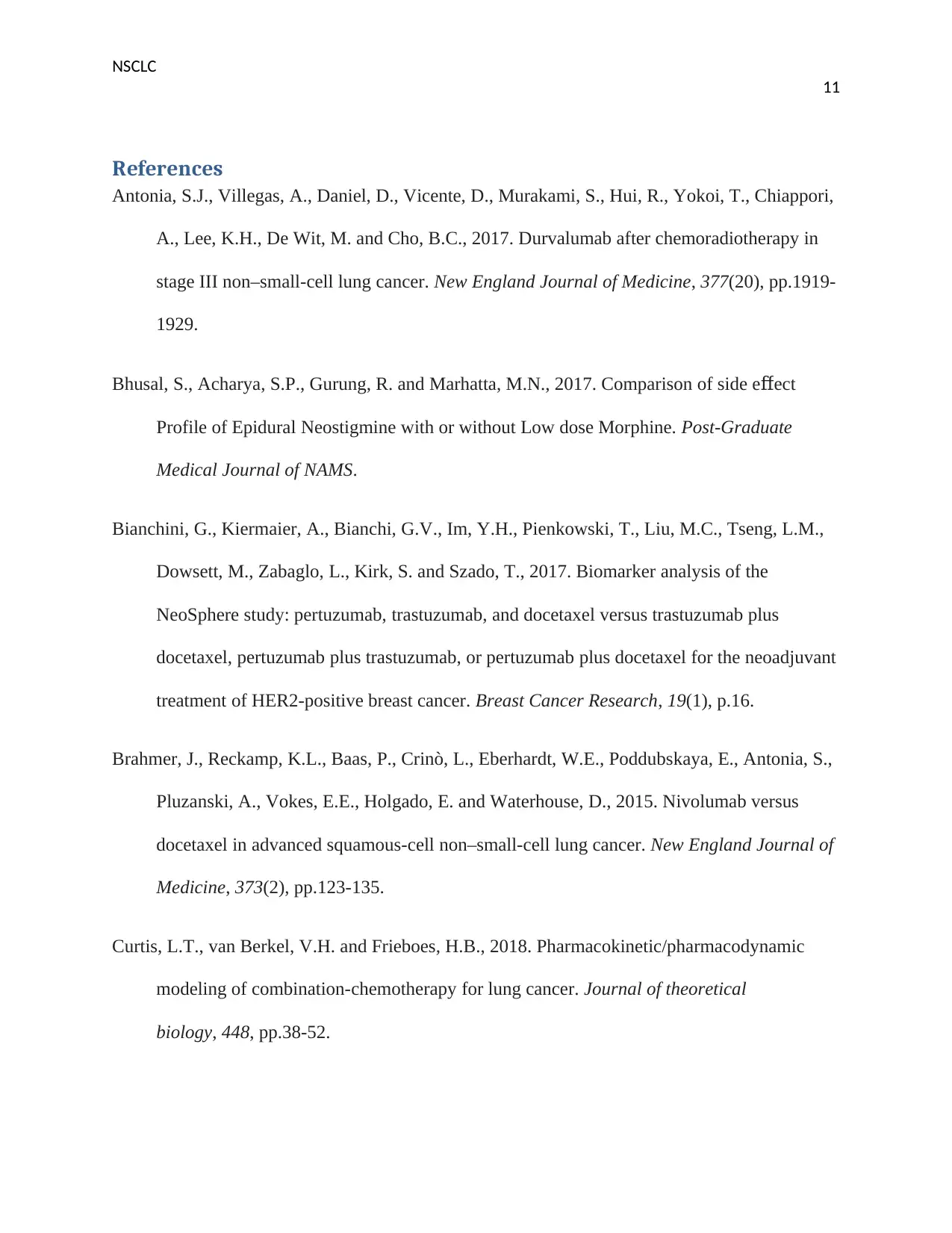
NSCLC
11
References
Antonia, S.J., Villegas, A., Daniel, D., Vicente, D., Murakami, S., Hui, R., Yokoi, T., Chiappori,
A., Lee, K.H., De Wit, M. and Cho, B.C., 2017. Durvalumab after chemoradiotherapy in
stage III non–small-cell lung cancer. New England Journal of Medicine, 377(20), pp.1919-
1929.
Bhusal, S., Acharya, S.P., Gurung, R. and Marhatta, M.N., 2017. Comparison of side effect
Profile of Epidural Neostigmine with or without Low dose Morphine. Post-Graduate
Medical Journal of NAMS.
Bianchini, G., Kiermaier, A., Bianchi, G.V., Im, Y.H., Pienkowski, T., Liu, M.C., Tseng, L.M.,
Dowsett, M., Zabaglo, L., Kirk, S. and Szado, T., 2017. Biomarker analysis of the
NeoSphere study: pertuzumab, trastuzumab, and docetaxel versus trastuzumab plus
docetaxel, pertuzumab plus trastuzumab, or pertuzumab plus docetaxel for the neoadjuvant
treatment of HER2-positive breast cancer. Breast Cancer Research, 19(1), p.16.
Brahmer, J., Reckamp, K.L., Baas, P., Crinò, L., Eberhardt, W.E., Poddubskaya, E., Antonia, S.,
Pluzanski, A., Vokes, E.E., Holgado, E. and Waterhouse, D., 2015. Nivolumab versus
docetaxel in advanced squamous-cell non–small-cell lung cancer. New England Journal of
Medicine, 373(2), pp.123-135.
Curtis, L.T., van Berkel, V.H. and Frieboes, H.B., 2018. Pharmacokinetic/pharmacodynamic
modeling of combination-chemotherapy for lung cancer. Journal of theoretical
biology, 448, pp.38-52.
11
References
Antonia, S.J., Villegas, A., Daniel, D., Vicente, D., Murakami, S., Hui, R., Yokoi, T., Chiappori,
A., Lee, K.H., De Wit, M. and Cho, B.C., 2017. Durvalumab after chemoradiotherapy in
stage III non–small-cell lung cancer. New England Journal of Medicine, 377(20), pp.1919-
1929.
Bhusal, S., Acharya, S.P., Gurung, R. and Marhatta, M.N., 2017. Comparison of side effect
Profile of Epidural Neostigmine with or without Low dose Morphine. Post-Graduate
Medical Journal of NAMS.
Bianchini, G., Kiermaier, A., Bianchi, G.V., Im, Y.H., Pienkowski, T., Liu, M.C., Tseng, L.M.,
Dowsett, M., Zabaglo, L., Kirk, S. and Szado, T., 2017. Biomarker analysis of the
NeoSphere study: pertuzumab, trastuzumab, and docetaxel versus trastuzumab plus
docetaxel, pertuzumab plus trastuzumab, or pertuzumab plus docetaxel for the neoadjuvant
treatment of HER2-positive breast cancer. Breast Cancer Research, 19(1), p.16.
Brahmer, J., Reckamp, K.L., Baas, P., Crinò, L., Eberhardt, W.E., Poddubskaya, E., Antonia, S.,
Pluzanski, A., Vokes, E.E., Holgado, E. and Waterhouse, D., 2015. Nivolumab versus
docetaxel in advanced squamous-cell non–small-cell lung cancer. New England Journal of
Medicine, 373(2), pp.123-135.
Curtis, L.T., van Berkel, V.H. and Frieboes, H.B., 2018. Pharmacokinetic/pharmacodynamic
modeling of combination-chemotherapy for lung cancer. Journal of theoretical
biology, 448, pp.38-52.
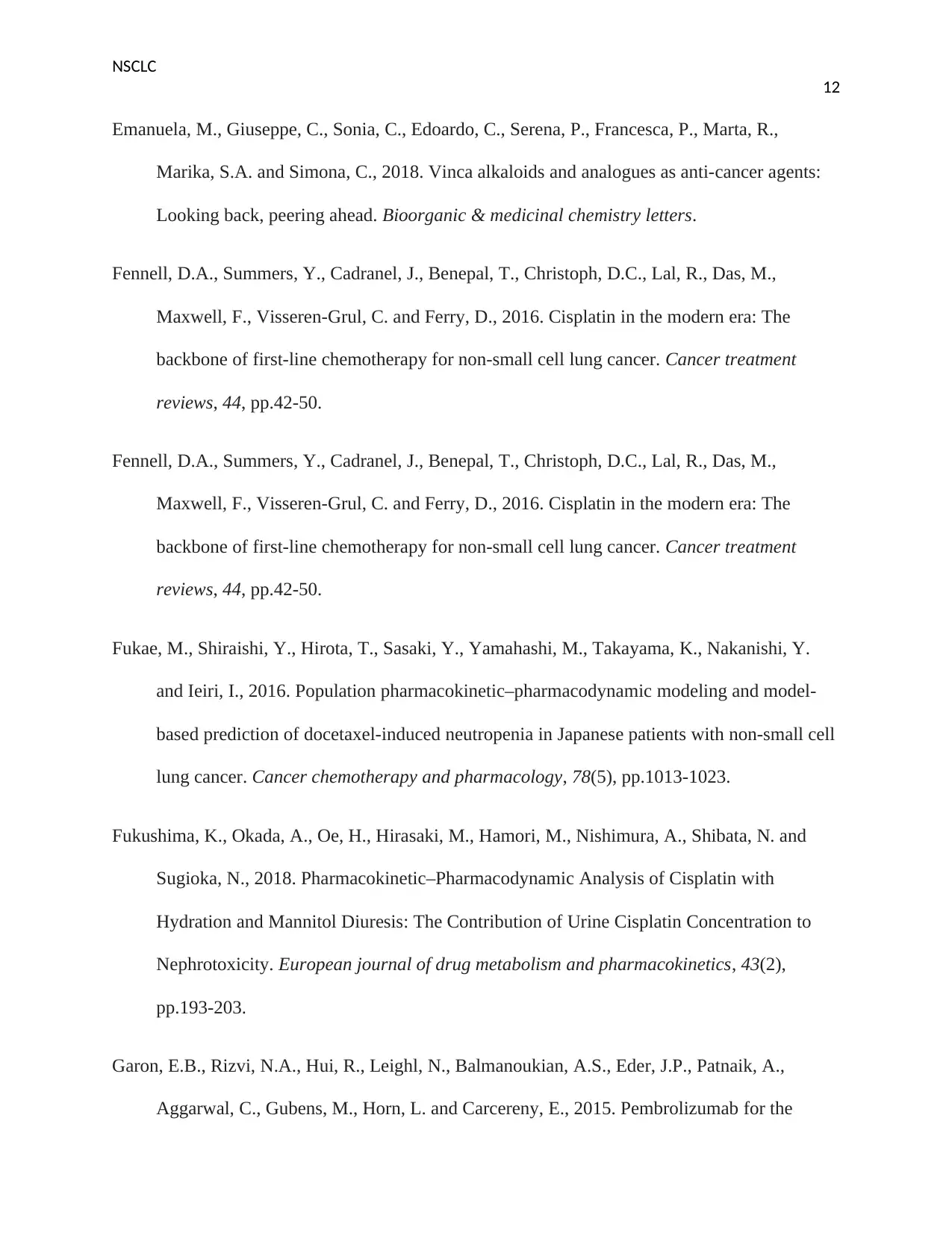
NSCLC
12
Emanuela, M., Giuseppe, C., Sonia, C., Edoardo, C., Serena, P., Francesca, P., Marta, R.,
Marika, S.A. and Simona, C., 2018. Vinca alkaloids and analogues as anti-cancer agents:
Looking back, peering ahead. Bioorganic & medicinal chemistry letters.
Fennell, D.A., Summers, Y., Cadranel, J., Benepal, T., Christoph, D.C., Lal, R., Das, M.,
Maxwell, F., Visseren-Grul, C. and Ferry, D., 2016. Cisplatin in the modern era: The
backbone of first-line chemotherapy for non-small cell lung cancer. Cancer treatment
reviews, 44, pp.42-50.
Fennell, D.A., Summers, Y., Cadranel, J., Benepal, T., Christoph, D.C., Lal, R., Das, M.,
Maxwell, F., Visseren-Grul, C. and Ferry, D., 2016. Cisplatin in the modern era: The
backbone of first-line chemotherapy for non-small cell lung cancer. Cancer treatment
reviews, 44, pp.42-50.
Fukae, M., Shiraishi, Y., Hirota, T., Sasaki, Y., Yamahashi, M., Takayama, K., Nakanishi, Y.
and Ieiri, I., 2016. Population pharmacokinetic–pharmacodynamic modeling and model-
based prediction of docetaxel-induced neutropenia in Japanese patients with non-small cell
lung cancer. Cancer chemotherapy and pharmacology, 78(5), pp.1013-1023.
Fukushima, K., Okada, A., Oe, H., Hirasaki, M., Hamori, M., Nishimura, A., Shibata, N. and
Sugioka, N., 2018. Pharmacokinetic–Pharmacodynamic Analysis of Cisplatin with
Hydration and Mannitol Diuresis: The Contribution of Urine Cisplatin Concentration to
Nephrotoxicity. European journal of drug metabolism and pharmacokinetics, 43(2),
pp.193-203.
Garon, E.B., Rizvi, N.A., Hui, R., Leighl, N., Balmanoukian, A.S., Eder, J.P., Patnaik, A.,
Aggarwal, C., Gubens, M., Horn, L. and Carcereny, E., 2015. Pembrolizumab for the
12
Emanuela, M., Giuseppe, C., Sonia, C., Edoardo, C., Serena, P., Francesca, P., Marta, R.,
Marika, S.A. and Simona, C., 2018. Vinca alkaloids and analogues as anti-cancer agents:
Looking back, peering ahead. Bioorganic & medicinal chemistry letters.
Fennell, D.A., Summers, Y., Cadranel, J., Benepal, T., Christoph, D.C., Lal, R., Das, M.,
Maxwell, F., Visseren-Grul, C. and Ferry, D., 2016. Cisplatin in the modern era: The
backbone of first-line chemotherapy for non-small cell lung cancer. Cancer treatment
reviews, 44, pp.42-50.
Fennell, D.A., Summers, Y., Cadranel, J., Benepal, T., Christoph, D.C., Lal, R., Das, M.,
Maxwell, F., Visseren-Grul, C. and Ferry, D., 2016. Cisplatin in the modern era: The
backbone of first-line chemotherapy for non-small cell lung cancer. Cancer treatment
reviews, 44, pp.42-50.
Fukae, M., Shiraishi, Y., Hirota, T., Sasaki, Y., Yamahashi, M., Takayama, K., Nakanishi, Y.
and Ieiri, I., 2016. Population pharmacokinetic–pharmacodynamic modeling and model-
based prediction of docetaxel-induced neutropenia in Japanese patients with non-small cell
lung cancer. Cancer chemotherapy and pharmacology, 78(5), pp.1013-1023.
Fukushima, K., Okada, A., Oe, H., Hirasaki, M., Hamori, M., Nishimura, A., Shibata, N. and
Sugioka, N., 2018. Pharmacokinetic–Pharmacodynamic Analysis of Cisplatin with
Hydration and Mannitol Diuresis: The Contribution of Urine Cisplatin Concentration to
Nephrotoxicity. European journal of drug metabolism and pharmacokinetics, 43(2),
pp.193-203.
Garon, E.B., Rizvi, N.A., Hui, R., Leighl, N., Balmanoukian, A.S., Eder, J.P., Patnaik, A.,
Aggarwal, C., Gubens, M., Horn, L. and Carcereny, E., 2015. Pembrolizumab for the
Paraphrase This Document
Need a fresh take? Get an instant paraphrase of this document with our AI Paraphraser
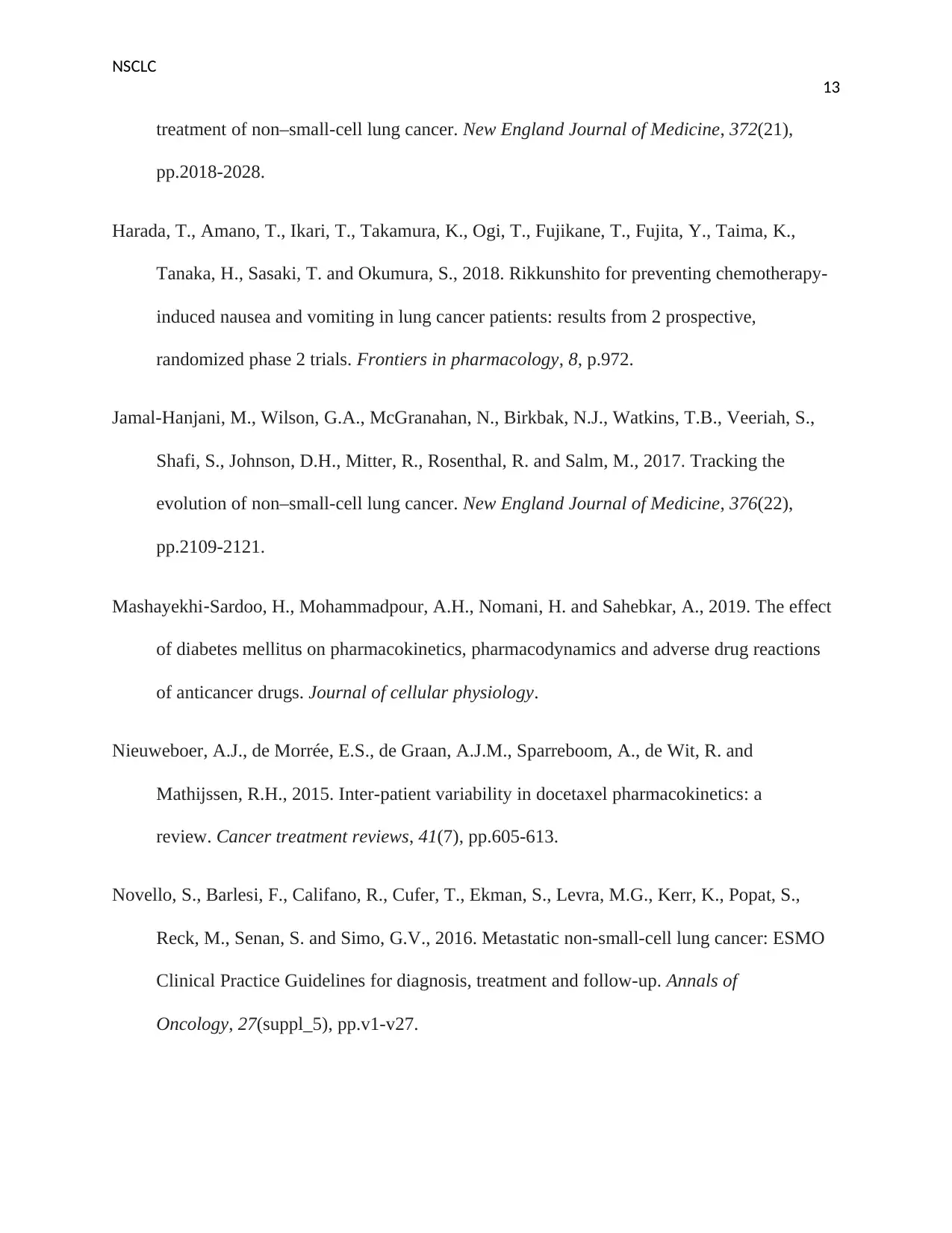
NSCLC
13
treatment of non–small-cell lung cancer. New England Journal of Medicine, 372(21),
pp.2018-2028.
Harada, T., Amano, T., Ikari, T., Takamura, K., Ogi, T., Fujikane, T., Fujita, Y., Taima, K.,
Tanaka, H., Sasaki, T. and Okumura, S., 2018. Rikkunshito for preventing chemotherapy-
induced nausea and vomiting in lung cancer patients: results from 2 prospective,
randomized phase 2 trials. Frontiers in pharmacology, 8, p.972.
Jamal-Hanjani, M., Wilson, G.A., McGranahan, N., Birkbak, N.J., Watkins, T.B., Veeriah, S.,
Shafi, S., Johnson, D.H., Mitter, R., Rosenthal, R. and Salm, M., 2017. Tracking the
evolution of non–small-cell lung cancer. New England Journal of Medicine, 376(22),
pp.2109-2121.
Mashayekhi‐Sardoo, H., Mohammadpour, A.H., Nomani, H. and Sahebkar, A., 2019. The effect
of diabetes mellitus on pharmacokinetics, pharmacodynamics and adverse drug reactions
of anticancer drugs. Journal of cellular physiology.
Nieuweboer, A.J., de Morrée, E.S., de Graan, A.J.M., Sparreboom, A., de Wit, R. and
Mathijssen, R.H., 2015. Inter-patient variability in docetaxel pharmacokinetics: a
review. Cancer treatment reviews, 41(7), pp.605-613.
Novello, S., Barlesi, F., Califano, R., Cufer, T., Ekman, S., Levra, M.G., Kerr, K., Popat, S.,
Reck, M., Senan, S. and Simo, G.V., 2016. Metastatic non-small-cell lung cancer: ESMO
Clinical Practice Guidelines for diagnosis, treatment and follow-up. Annals of
Oncology, 27(suppl_5), pp.v1-v27.
13
treatment of non–small-cell lung cancer. New England Journal of Medicine, 372(21),
pp.2018-2028.
Harada, T., Amano, T., Ikari, T., Takamura, K., Ogi, T., Fujikane, T., Fujita, Y., Taima, K.,
Tanaka, H., Sasaki, T. and Okumura, S., 2018. Rikkunshito for preventing chemotherapy-
induced nausea and vomiting in lung cancer patients: results from 2 prospective,
randomized phase 2 trials. Frontiers in pharmacology, 8, p.972.
Jamal-Hanjani, M., Wilson, G.A., McGranahan, N., Birkbak, N.J., Watkins, T.B., Veeriah, S.,
Shafi, S., Johnson, D.H., Mitter, R., Rosenthal, R. and Salm, M., 2017. Tracking the
evolution of non–small-cell lung cancer. New England Journal of Medicine, 376(22),
pp.2109-2121.
Mashayekhi‐Sardoo, H., Mohammadpour, A.H., Nomani, H. and Sahebkar, A., 2019. The effect
of diabetes mellitus on pharmacokinetics, pharmacodynamics and adverse drug reactions
of anticancer drugs. Journal of cellular physiology.
Nieuweboer, A.J., de Morrée, E.S., de Graan, A.J.M., Sparreboom, A., de Wit, R. and
Mathijssen, R.H., 2015. Inter-patient variability in docetaxel pharmacokinetics: a
review. Cancer treatment reviews, 41(7), pp.605-613.
Novello, S., Barlesi, F., Califano, R., Cufer, T., Ekman, S., Levra, M.G., Kerr, K., Popat, S.,
Reck, M., Senan, S. and Simo, G.V., 2016. Metastatic non-small-cell lung cancer: ESMO
Clinical Practice Guidelines for diagnosis, treatment and follow-up. Annals of
Oncology, 27(suppl_5), pp.v1-v27.
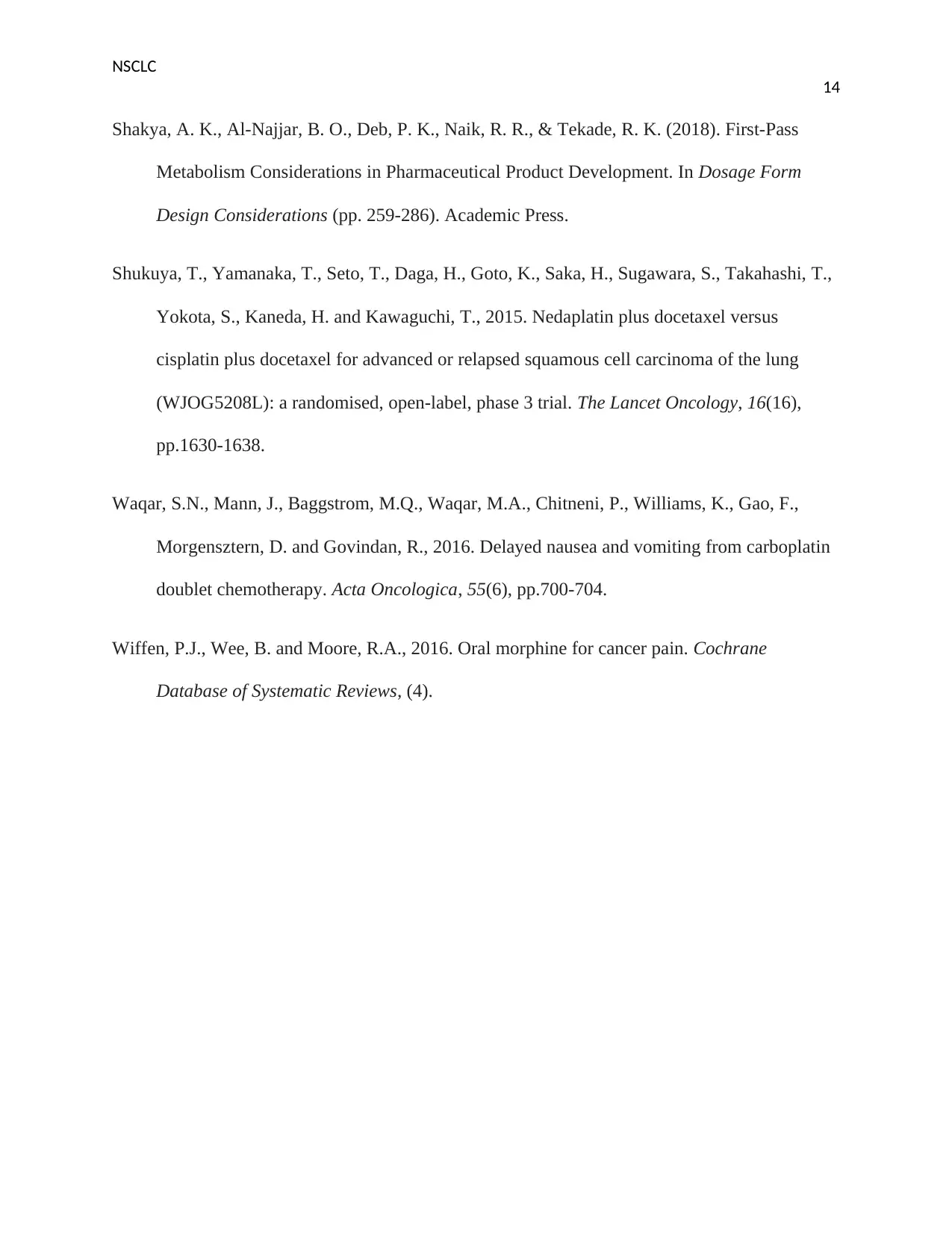
NSCLC
14
Shakya, A. K., Al-Najjar, B. O., Deb, P. K., Naik, R. R., & Tekade, R. K. (2018). First-Pass
Metabolism Considerations in Pharmaceutical Product Development. In Dosage Form
Design Considerations (pp. 259-286). Academic Press.
Shukuya, T., Yamanaka, T., Seto, T., Daga, H., Goto, K., Saka, H., Sugawara, S., Takahashi, T.,
Yokota, S., Kaneda, H. and Kawaguchi, T., 2015. Nedaplatin plus docetaxel versus
cisplatin plus docetaxel for advanced or relapsed squamous cell carcinoma of the lung
(WJOG5208L): a randomised, open-label, phase 3 trial. The Lancet Oncology, 16(16),
pp.1630-1638.
Waqar, S.N., Mann, J., Baggstrom, M.Q., Waqar, M.A., Chitneni, P., Williams, K., Gao, F.,
Morgensztern, D. and Govindan, R., 2016. Delayed nausea and vomiting from carboplatin
doublet chemotherapy. Acta Oncologica, 55(6), pp.700-704.
Wiffen, P.J., Wee, B. and Moore, R.A., 2016. Oral morphine for cancer pain. Cochrane
Database of Systematic Reviews, (4).
14
Shakya, A. K., Al-Najjar, B. O., Deb, P. K., Naik, R. R., & Tekade, R. K. (2018). First-Pass
Metabolism Considerations in Pharmaceutical Product Development. In Dosage Form
Design Considerations (pp. 259-286). Academic Press.
Shukuya, T., Yamanaka, T., Seto, T., Daga, H., Goto, K., Saka, H., Sugawara, S., Takahashi, T.,
Yokota, S., Kaneda, H. and Kawaguchi, T., 2015. Nedaplatin plus docetaxel versus
cisplatin plus docetaxel for advanced or relapsed squamous cell carcinoma of the lung
(WJOG5208L): a randomised, open-label, phase 3 trial. The Lancet Oncology, 16(16),
pp.1630-1638.
Waqar, S.N., Mann, J., Baggstrom, M.Q., Waqar, M.A., Chitneni, P., Williams, K., Gao, F.,
Morgensztern, D. and Govindan, R., 2016. Delayed nausea and vomiting from carboplatin
doublet chemotherapy. Acta Oncologica, 55(6), pp.700-704.
Wiffen, P.J., Wee, B. and Moore, R.A., 2016. Oral morphine for cancer pain. Cochrane
Database of Systematic Reviews, (4).
1 out of 15
Related Documents
Your All-in-One AI-Powered Toolkit for Academic Success.
+13062052269
info@desklib.com
Available 24*7 on WhatsApp / Email
![[object Object]](/_next/static/media/star-bottom.7253800d.svg)
Unlock your academic potential
© 2024 | Zucol Services PVT LTD | All rights reserved.





